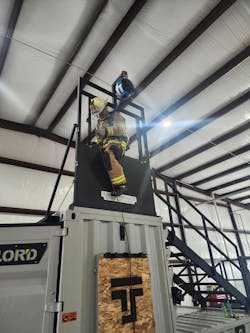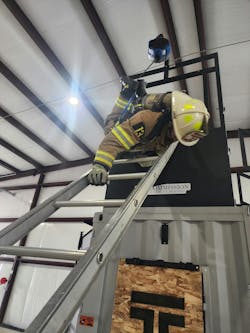Firehouse Labs: Head Rush Technologies TruBlue SafeLine Controlled Descent Device
Firehouse Labs completed a field test of Head Rush Technologies’ TruBlue SafeLine Controlled Descent Device at the Kentucky Fire Commission State Fire Rescue Training Center located in London, KY. Several rounds of testing were conducted, starting with a rescue manikin and finishing with instructors and various bailout scenarios. Testing was accomplished at an indoor facility with a commercially available two-story training tower. The training tower’s anchor point was designed to incorporate a safety belay for bailout training. Instructors were first-time users of the product, which was useful in the evaluation of the device’s ease of setup and utilization.
The fundamentals
Head Rush Technologies has been trusted by more than 70,000 customers, most of which until recently have been climbers. With more than 250 devices sold to the fire service, the company hopes to improve firefighter safety when completing training that might involve a potential fall. Currently seeking NFPA approval, the device is designed with proprietary magnetic braking that produces a smooth descent should it be needed. It is currently certified with elements from:
- EN 341: 2011 - Personal protective equipment against falls from a height - Descender devices
- EN 360:2002 - Personal protective equipment against falls from a height - Retractable type fall arresters
- RFU PPE-R/11.128:2019 - Recommended for Use for descent control devices used in climbing gyms, rope courses
The evaluation
The TruBlue SafeLine was easier to set up than a manual belay, and no human interaction was required to engage the device. Even for first-time users, the device’s operation was intuitive.
The device was mounted easily to the two-story Taylor’d Series 12 training prop that had an angled bracket that was designed to hold a belay system, though the bracket was barely at the minimum mounting height that’s listed on the product specifications. Firehouse Labs was told that other users reported employing the device on a third-story trainer with no concerns over the minimum specifications.
The device weighs 35 lbs. and is designed to safely lower a person who weighs 22–309 lbs. With several options for webbing length and endpoint connections, the versatile tool can be tailored to fit most training scenarios. With a little practice, the instructors were able to identify the best way to connect the TruBlue carabiner to the manikin/instructor to limit interference with fire gear and SCBA.
In every scenario, the device functioned as advertised and safely lowered the manikin/person to the ground. Compared with a manual belay, there was no delay in deployment nor sudden jerk of being caught, and the single retractable webbing was less obtrusive to the training environment than a rope-and-pulley system.
From a practical standpoint, the way that the device was mounted was more conducive for bailout drills than ladder bailouts, as the manufacturer recommends mounting the device directly above the load. However, with a minor modification to the training prop, the device could easily support both types of drills.
When evaluating the effect on the training, the device didn’t impede bailout maneuvers, which sometimes can be a problem for a less-experienced manual belay attendant. For such a short distance, which still has the potential to injure someone, it was nice to not worry about the delay that’s associated with the attendant’s reaction time for a manual belay.
The device was easily reset (by releasing the belay line, so it could self-retract) between drill participants, which also is a nice factor when considering larger class sizes or needing to get an entire shift through bailout training quickly.
Another factor to consider is staffing at drills. This device essentially replaced the one to two people who generally are placed on belay detail for these types of drills. For some departments, this will be an added level of safety without increasing the cost of training.
Based on our independent testing, Firehouse Labs can confirm that it’s safer to use the TruBlue SafeLine compared with no belay and more efficient than a manual belay. For these reasons, the TruBlue SafeLine receives the Firehouse Labs Seal of Approval.
About the Author
Firehouse Staff
Content written and created by Firehouse Magazine editors.

